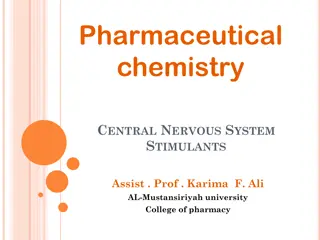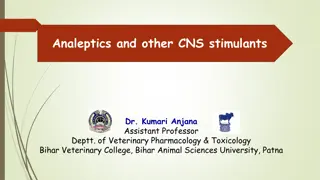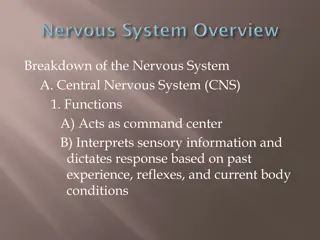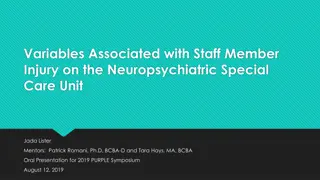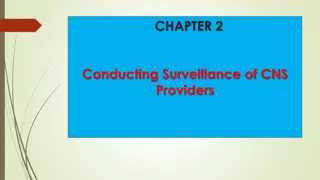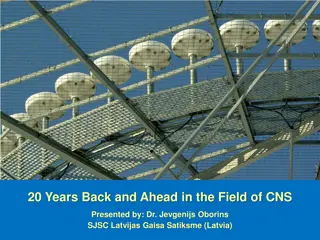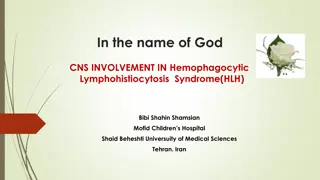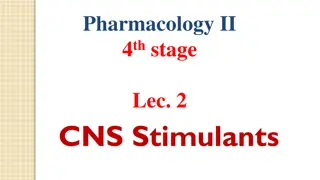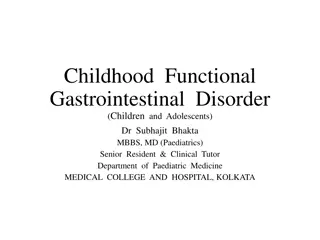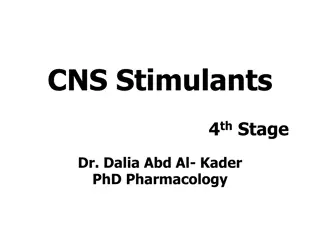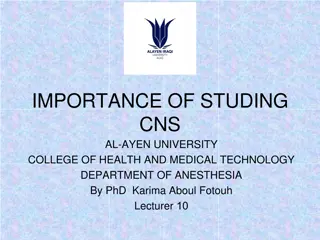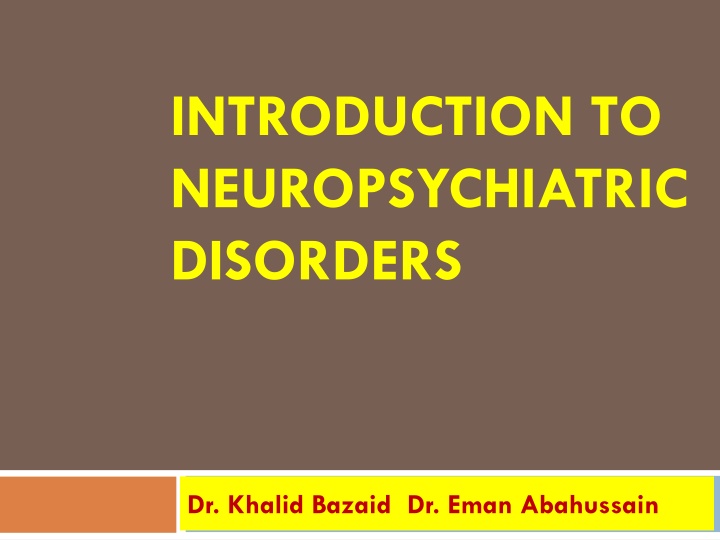
Cognitive Disorders: Causes, Symptoms, and Diagnosis
Learn about cognitive disorders, including their impact on memory, judgment, and language. Explore the complexities of neuropsychiatric conditions such as delirium, their epidemiology, etiology, and diagnostic criteria, for a comprehensive understanding of these conditions.
Download Presentation

Please find below an Image/Link to download the presentation.
The content on the website is provided AS IS for your information and personal use only. It may not be sold, licensed, or shared on other websites without obtaining consent from the author. If you encounter any issues during the download, it is possible that the publisher has removed the file from their server.
You are allowed to download the files provided on this website for personal or commercial use, subject to the condition that they are used lawfully. All files are the property of their respective owners.
The content on the website is provided AS IS for your information and personal use only. It may not be sold, licensed, or shared on other websites without obtaining consent from the author.
E N D
Presentation Transcript
INTRODUCTION TO NEUROPSYCHIATRIC DISORDERS Dr. Khalid Bazaid Dr. Eman Abahussain
Definition Cognition orientation, judgment, conducting interpersonal relationships, performing actions (praxis), and problem solving includes memory, language,
Definition Cognitive disorders are characterized by significant impairment in functions such as memory, judgment, language, and attention. this impairment represent a change from base line. Cognitive disorders reflect disruption in one or more of the above domains, and are also frequently complicated by behavioral symptoms.
Definition Cognitive disorders represent the complex interface between neurology, medicine, and psychiatry Organic mental disorders or organic brain disorders VS Functional disorders Advances in molecular biology, diagnostic techniques, and medication management improved the ability to recognize and to treat cognitive disorders. have significantly
Delirium Delirium is an impairment of consciousness (short- term confusion and changes in cognition) Usually accompanied by global impairment of cognitive functions, associated with emotional lability, hallucinations or illusions and inappropriate behavior. It is an acute reversible condition.
Epidemiology: Common among hospitalized patients, about 10% of all hospitalized patients. Very young and elderly are more susceptible to delirium. Patients with history of delirium or brain injury are more likely to have an episode of delirium than the general population.
Etiology: Major causes include systemic disease, CNS disease, and either intoxication with or Withdrawal from prescribed medications, or drug of abuse. Delirium is thought to involve dysfunction of reticular formation and acetyl-choline transmission. Noradrenergic hyperactivity has been associated with alcohol withdrawal delirium.
Diagnosis: It is diagnosed according to etiology: delirium due to medical condition, substance intoxication delirium, substance withdrawal delirium. Key features: disturbance of consciousness, change in cognition, or the development of perceptual disturbance, over a short period of time and tend to fluctuate during the day.
Management Laboratory tests: Delirium is a medical emergency, its cause must be identefied as quick as possible. Treatment: Identify and treat the underlying cause.
Dementia It is characterized by severe multiple cognitive deficits, including memory loss. Consciousness is not impaired. The perception, intellectual functioning, and reasoning. major defects involve orientation, memory, The defects represent a change from baseline and interfere with functioning.
Dementia contd Marked changes in personality, affect, and may be associated with behavioral problems. Dementias hallucinations(20-30%),and delusions(30-40%). are commonly accompanied by Symptoms of depression and anxiety are present in 40-50%of pts with dementia.
Epidemiology: A syndrome of the elderly, 5%of Americans over the age of 65 have sever dementia, and 15% have mild dementia. Increasing age is the most important risk factor. 15% of dementia cases are reversible.
Etiology: Most common cause is Alzheimer's disease (50-60%) followed by vascular disease. Other common causes include head trauma , alcohol , movement disorders (such as Huntington's disease and parkinsonism) and HIV infection.
Diagnosis: Dementia of the Alzheimer's type, which usually occurs in persons over 65 years of age and is manifested by progressive intellectual disorientation and dementia, delusions, or depression Vascular dementia, caused by vessel thrombosis or hemorrhage Other medical conditions (e.g. human immunodeficiency virus [HIV] disease, head trauma, Pick's disease, Creutzfeldt-Jakob disease, which is caused by a slow-growing transmittable virus) Substance induced, caused by toxin or medication (e.g., gasoline fumes, atropine) Multiple etiologies Not otherwise specified (if cause is unknown). 1. 2. 3. 4. 5. 6.
Management: Potentially reversible causes for the dementia (hypothyroidism, CNS syphilis, subdural hematoma, vit B12 deficiency, uremia, hypoxia). Identify other treatable medical conditions that may worsen the dementia.
Management contd Supportive measures. Ensure proper treatment of any underlying medical problems or associated disrubtive symptoms. Maintain proper nutrition, exercise, and daily activities. Provide an environment with frequent cues for orientation to day, date, place, and time. As functioning decreases, nursing home placement may be necessary.
Course and prognosis: Dementia may be progressive, remitting, or stable. In reversible causes of dementia the course depends on how quickly the cause is reversed. For Dementia of Alzheimer's type the course is likely to be one of slow deterioration.
How to differentiate between Delirium & Dementia Delirium Dementia History of Chronic disease. Insidious onset Duration months-years. Progressive course, majority irreversible. level of consciousness Normal early on. Normal level of arousal. Usually in nursing homes and psychiatric hospitals. History of Acute disease. Rapid onset. Duration days-weeks. Fluctuating course, often reversible Fluctuating level of consciousness. Agitation or stupor. In medical, surgical and neurological words.
Amnestic disorder Impaired recent short term and long term memory attributed to a specific organic cause (drug or medical disease) patient is normal in other areas of cognition.
Diagnosis: The development of memory impairment as manifested by impairment in the ability to learn new information or the inability to recall previously learned information. The memory impairment cause significant impairment in social or occupational functioning. The memory impairment dose not occur during the course of a delirium or dementia. The disturbance is due to general medical condition or substance.
Etiology: Most common form is caused by thiamine deficiency associated with alcohol dependence. May also result from head trauma, tumor, surgery, hypoxia, infraction, seizures and herpes simplex encephalitis. Typically diencephalic structures (lympic system, hypothalamus, thalamus) and temporal structures (mamillary bodies, fornix, hippocampus) can cause the disorder. any process that damages certain
Management: Identify the cause and reverse it if possible, otherwise, institute supportive medical procedures.
Thank You for your attention






